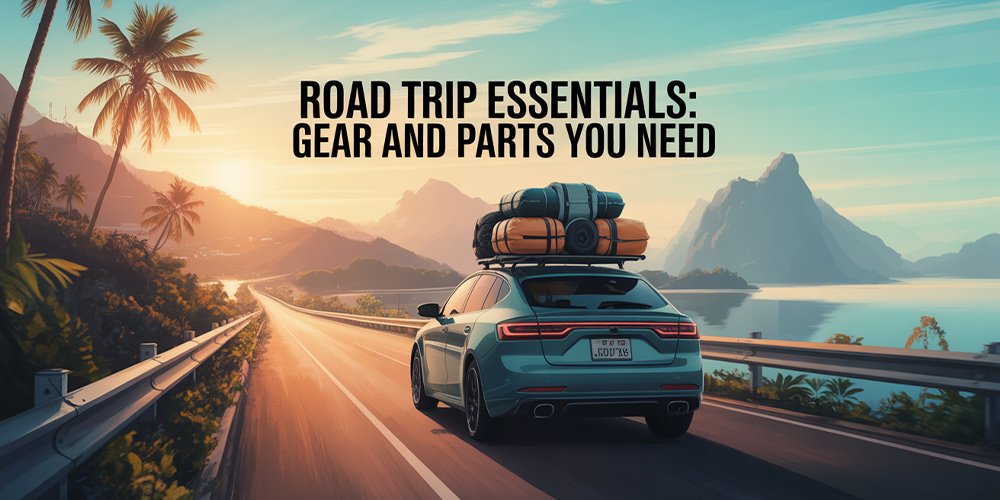
Few experiences capture freedom quite like a road trip through the Philippines. From the pine-scented curves of Baguio to the seaside highways of Cebu and the wild open stretches of Mindanao, every kilometer holds a story. But with the thrill of the open road comes the responsibility of preparation — unpredictable weather, uneven roads, and limited service stations can quickly turn adventure into stress.
This comprehensive guide brings together expert insights and field-tested advice to help you prepare the right gear and car parts for a safe, smooth, and memorable drive across the archipelago. Whether you’re planning a weekend getaway or a cross-island expedition, these essentials will keep you ready for anything the road throws your way.
Before packing your gear, ensure your car is roadworthy. The basics still matter most:
For a deeper guide on getting your car road-ready before a long drive, check out our article on How to Prepare Your Car for Long Drives.

Pack all legal documents:
Key Tip: Store all documents in a waterproof folder and keep a second copy in your glove box.
A complete emergency kit can make the difference between a minor delay and a major problem. Include:
Key Takeaway: In provinces like Kalinga or Bukidnon, help might be hours away. Having your own safety gear means independence and security.

Even a well-maintained car can face surprises on Philippine roads. Bring:
Quick Fix Tip: If a hose leaks, wrap it temporarily with duct tape reinforced with a clamp until you reach the next service station.
If you want to upgrade your setup, see our list of the Top 10 Must-Have Car Accessories for Filipino Drivers in 2025 for tools and gadgets that can make every trip smoother.
In a country with patchy signal zones, having multiple navigation tools matters:
Planning to buy these tools online? Read our quick guide on How to Choose the Best Car Accessories Online to make sure you get reliable gear for your next trip.
Long drives are better when everyone is comfortable:
Quick Reminder: Sudden downpours can flood low-lying roads — always check local advisories before departure.
| Part | Why You Need It | Philippine-Specific Tip |
| Spare tire & patch kit | Tire damage is common on provincial gravel roads | Inflate to 30–35 PSI before departure |
| Belts (fan/serpentine) | High heat can cause wear or breakage | Keep a compatible spare in a labeled pouch |
| Spark plugs | Maintain smooth engine performance | Bring a full set if trip exceeds 500 km |
| Coolant | Prevents overheating on steep climbs | 3–5 liters in trunk recommended |
| Fuses & bulbs | Replace instantly if lights fail | Carry assorted types for your vehicle |
| Hose clamps | Quick fix for leaks | Use stainless steel to resist corrosion |
| Engine oil | For topping up mid-trip | Minimum 1 liter extra |
Home to expressways and mountain passes alike — from the SCTEX to Benguet. Be ready for sudden elevation changes and fog. Ensure your brakes and lights are in top shape.
Expect ferry crossings and scenic coastal routes. Secure gear tightly against sea spray and vibration. Carry extra fuel in approved containers for rural stretches.
Wide highways contrast with isolated provinces. Always check travel advisories and refuel early — gas stations can be sparse in mountainous regions like Bukidnon and Compostela Valley.
Key Takeaway: Each region has unique terrain — your readiness should match the journey’s demands.

Every road trip in the Philippines promises adventure — but only those who prepare can enjoy it without worry. By packing essential tools, spare parts, and smart gear, you’re not just preparing for breakdowns; you’re empowering yourself for freedom and safety.
Before every drive, do one last check, review your list, and remember: the best journeys happen when readiness meets the open road. So fuel up, gear up, and go explore — the islands are waiting.
Since 2012, KG Car PH has been the go-to for affordable car parts in the Philippines. We make it easy to find the right fit and offer same-day delivery nationwide—so you get quality parts fast, without spending more.
SOCIAL MEDIA
TOP CATEGORIES
QUICK LINKS
© 2025 KGCAR.PH